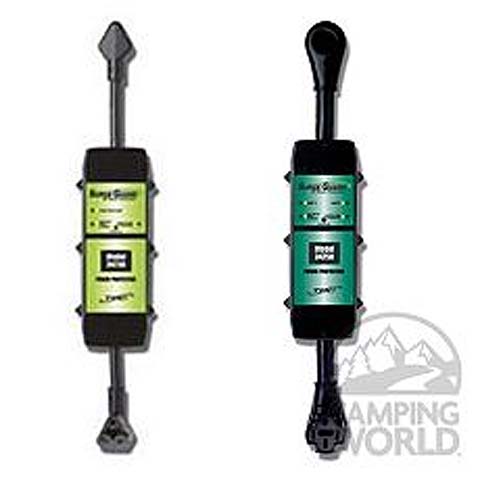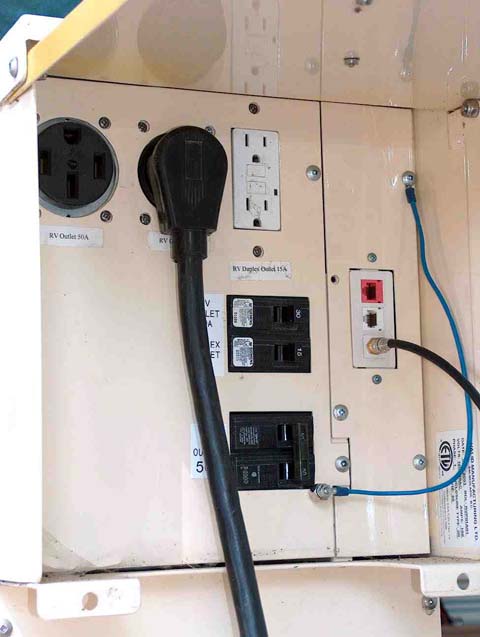What does all that mean? The strength of the electrical current is amperage and is generally dependent on wire size, so pat testing regulations are indeed. When you live in a stick and brick house you do not worry about electricity at all. You turn on the lights, run your air conditioner and microwave all at the same time and not even think about it. While all those are running you probably have the TV (several), hot water heater and lots of other appliances running. Not once do you stop to think, if I turn on this appliance will it blow a fuse?In a 5th wheel or trailer you are very well aware of what might happen if you turn on an electric appliance that takes a lot of juice to run.How do we supply power to our 5th wheel? When we arrive at a RV park in the states you have your choice (and price) of 30 AMP or 50 AMP electric plugs. The main difference if it is summertime and hot we always go with 50 AMP so we can run both air conditioners at the same time. If we choose 30 AMPS we sorta pay attention to how many electrical things we are running at a time. The 50 AMP electric cord is vey heavy to drag out of our basement (yes, that is what our storage compartments underneath are called) and take to the back of the 5th wheel and hook up. So if we are only staying one night at a park we may choose the 30 Amp because the cord is lighter to take out of a basket and carry to the back of the trailer where the hook up is. We can pull up to a site and just look at the plug and know what kind of amps we have. Even Tinka can tell the difference between a 15 amp, 30 amp and a 50 amp plug. We do have a couple of batteries just like a car does. It will run several lights in each room when we are not hooked up to a power source at a park.
So much for amperage, now we need to consider voltage which is the electric potential or force of the current. In the states you can expect a 120 volt system to be roughly 115 to 125 volts. Sometimes we’ll run into a park where the voltage may be on the low side. This is not the case in Mexico. If the RV park is wired and grounded correctly, and we always check, we usually find the voltage to be extremely high. It is typical for voltage to be 125 to 140 volts. Both conditions, either high or low voltage can shorten the life of many electrical components. Low voltage is worse for appliances like the microwave.
Now why am I telling you all this? So you will know what the electricity is like in Mexico. Most all RV parks in Mexico have 15 AMPS ONLY. That means you are not allowed to run your air conditioner. You also can not run your washer/dryer and the microwave at the same time or you might blow a breaker. Using the dryer cycle is usually a no-no. When we were in Mazatlan we did run our air conditioner because the park was not full. If all the sites had been full we would not have been able to do that. Of course, most of the regular people there were used to not running the A/C and so they had their doors open and didn’t run their A/C.
All that being said, about a year ago we had a built in Surge Guard installed to protect our unit against things like reversed polarity, missing ground, high and low voltage, spikes, etc. This was done by Camping World at no small expense. This is all well and good, except it generally prevents us from using the Mexican electric service due to the high voltage. Our Surge Guard has a key that allows us to bypass the unit. Bypassing the unit eliminates all of the protection that we paid for EXCEPT for surges in the electrical service. This is what we have been doing. Three times in the past 24 hours, the unit has cut off to protect from such surges.
I wouldn’t plan to travel to Mexico without one. Surge Guard also has an inline system that attaches to the power cord, but you can not bypass the high without completely removing the device.
Built in Surge Guard
Portable Surge Guard

The first thing we do at any park, even in the US, is check the voltage and quality of the electrical service before hooking up. If the tester indicates a problem, we have to analyse the condition. This may be missing ground, improper wiring such as ground and neutral reversed, or other problems.
Voltage Meter and Electrical Tester
Here is the typical RV electrical hookup that we are used to in the United States.

This is what we generally get in Mexico. Most of the time, if there is a breaker box, it is exposed to the elements and so are the outlets. It looks like they grounded it to the rebar in the cement.
This is our current hookup. Exposed to the elements and there is no cover on the outlet.
Electricity is very expensive in Mexico and the wiring is expensive. So most of the wires they use here in Mexico are the small size like a regular extension cord, not a thick extention cord. If a RV Park has 30 or 50 AMP it is because they have bought the wires in the states and brought them down.
Just to give you an idea regarding the expense. US electric rates are about $.12 per kilowatt hour. Next month when we move to Lo De Marcos, we will be paying $.27 per kilowat hour.
Thanks for the great info!